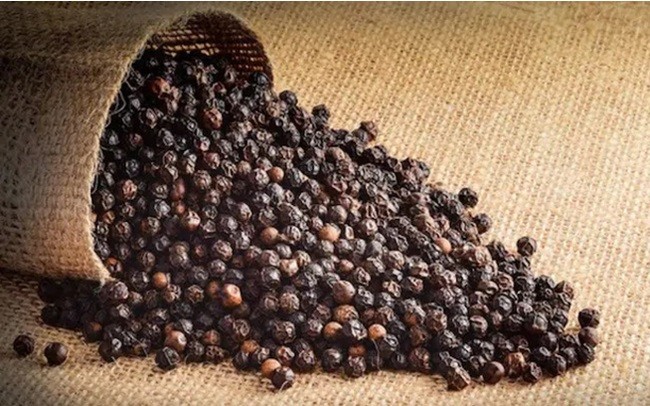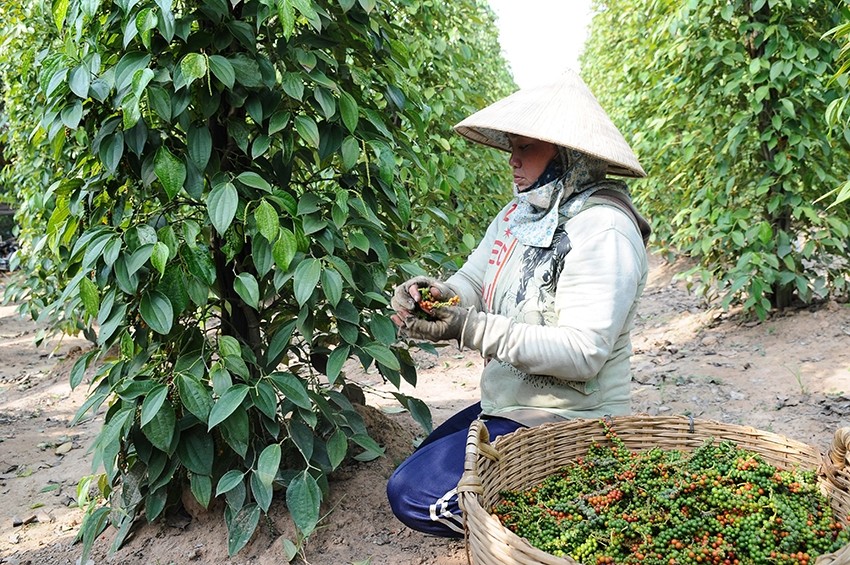Second pepper price fever, people still have enough goods
This year, pepper prices have unexpectedly increased sharply and entered a price fever for the second time in history. Experts and businesses say that pepper has officially entered a new price increase cycle after a period of being at rock bottom. It is worth noting that the price increase cycle could last more than a decade and it is very likely that this item will jump to the threshold of 350,000-400,000 VND/kg.
Vietnam’s pepper prices, often referred to as “black gold,” are skyrocketing, reaching a new all-time high. The sharp increase has propelled Vietnam to the top spot in the world for pepper prices, far surpassing major exporters such as Indonesia, Malaysia, and Brazil. This year, pepper prices have suddenly increased sharply, entering the second price fever in history, after climbing since 2010 and peaking in 2015 at VND230 million per ton.
Currently, Vietnam holds the world's largest pepper warehouse, accounting for 40% of global output and 60% of global exports. Vietnam's pepper output in 2024 is estimated to decrease by 10% compared to 2023, to only about 170,000 tons, the lowest level in the past 5 years. In this context, both domestic and export pepper prices have increased sharply.
 |
| Pepper prices suddenly increased sharply and entered the second price fever in history. |
The price of Vietnamese black pepper is trading at 7,800 USD/ton for 500 g/l; 8,000 USD/ton for 550 g/l; and 12,000 USD/ton for white pepper. Compared to the same period last year, the export prices of black and white pepper increased by 100% and 110.5%, respectively. This pushed the price of Vietnamese pepper higher than that of Indonesia, Malaysia and Brazil by several hundred to several thousand USD per ton.
On June 19, the International Pepper Community (IPC) listed Lampung black pepper price (Indonesia) at 6,418 USD/ton; Brazilian black pepper price ASTA 570 at 7,600 USD/ton; Kuching black pepper price (Malaysia) ASTA remained at 4,900 USD/ton. Muntok white pepper price 8,377 USD/ton; Malaysian white pepper price ASTA remained at 7,300 USD/ton.
In the first half of June, the price of Vietnamese pepper increased dramatically when it peaked at 180,000 VND/kg on June 12. Immediately after that, it quickly declined. According to the latest updated information, pepper prices on June 19 regained their upward momentum. In Dak Lak and Dak Nong provinces, pepper prices were at 162,000 VND/kg, the lowest price in Binh Phuoc province was 156,000 VND/kg. Over the past month, pepper prices have increased from 120,000 VND/kg to 150,000 VND/kg and continued to climb to 160,000 - 162,000 VND/kg on June 14.
The main reason for this price increase is the severe reduction in supply. Both domestic and global pepper production has decreased, while the inventory from the previous year is at its lowest level in the past 5 years. Drought and adverse weather conditions in major producing countries such as India, Indonesia, and Brazil have also contributed to the decrease in production.
According to the reporter of Cong Thuong Newspaper, this year's pepper crop, Ms. Nguyen Thi Thu Mai, Bau Lam commune, Xuyen Moc district, Ba Ria - Vung Tau province harvested 12 tons of pepper, down 2 tons compared to last year, but because the pepper price is high this year, she made a good profit, after deducting all expenses, she earned 500-600 million VND. This is a high profit compared to 3-4 years ago.
Mr. Le Xuan Liem in Hoa Binh commune, Xuyen Moc district, Ba Ria - Vung Tau province, owns 5.5 hectares of pepper garden, said that pepper prices are at the highest level in the past 6-7 years, helping growers have a good income. He is currently focusing on taking care of and improving his garden to increase output for the next crop when pepper prices are high.
Ms. Hoang Thi Lien - President of the Vietnam Pepper and Spice Association (VPSA), said that domestic pepper is on an upward trend, increasing by a few thousand VND/kg every day. People still have pepper but instead of selling it en masse, they choose to sell it in small quantities to wait and see how the price goes. There is no speculation in the market, and businesses are not buying much either.
Pepper price increase affects domestic market and export enterprises
According to the Vietnam Pepper and Spice Association (VPSA), in the first 5 months of 2024, Vietnam exported 114,424 tons of pepper of all kinds, earning 493.1 million USD, down 13.2% in volume but up 20.6% in export turnover over the same period last year. The average export price of black pepper reached 4,197 USD/ton and white pepper reached 5,804 USD/ton, up 754 USD and 849 USD respectively over the same period in 2023.
The rise in pepper prices has boosted Vietnam’s exports, which are forecast to continue growing in the remaining months of the second quarter of 2024 thanks to demand from European and American markets. However, some challenges remain. Import markets are strengthening regulations on product origin, requiring precise traceability and compliance with strict environmental standards.
For Vietnamese businesses, rising freight rates and production costs also create great pressure. Furthermore, competing with producers from other countries such as Indonesia and Brazil, where pepper prices are gradually becoming more competitive, is also a big challenge.
 |
| Pepper is still available among the people, but instead of selling it en masse, they choose to sell it little by little to wait and see how the price goes. |
According to the Vietnam Pepper and Spice Association (VPSA), Vietnam's pepper output in 2024 is estimated to decrease by 10% compared to 2023, to only about 170,000 tons. This is the lowest level in the past 5 years.
Mr. Hoang Phuoc Binh - Permanent Vice President of Chu Se Pepper Association (Gia Lai) said that in the context of a significant decrease in global pepper output, the inventory from last year carried over to this year in Vietnam is almost negligible, making it difficult to meet market demand. This is pushing pepper into a new price increase cycle. This cycle will last for the next 10 years and prices could reach 350,000 - 400,000 VND/kg.
This is good news for farmers but also poses many challenges for pepper exporting enterprises in ensuring supply and quality of goods. In the context of rising prices, enterprises find it difficult to proactively source goods because the amount of goods sold to the market is not abundant, while enterprises signed contracts in advance with fixed prices and now the price is too high, they cannot buy goods.
According to VPSA's assessment, Vietnam's pepper output in 2024 is estimated to decrease by 10% compared to 2023, to only about 170,000 tons - the lowest level in the past 5 years.
According to Mr. Nguyen Nam Hai, Chairman of the Vietnam Pepper Association (VPA), maintaining and developing the pepper industry sustainably is very important. VPA recommends that businesses need to prepare for new requirements from international markets.
Experts say that with low inventories and reduced output, pepper prices may continue to remain high in the short term. However, the market is likely to face difficulties if global demand declines due to economic instability and geopolitical conflicts.
Efforts to stabilize the market
With supply shortages and countries increasing imports, especially China, Vietnam's pepper prices are expected to increase sharply in the coming time. In May, Vietnam's pepper exports to China reached 3,137 tons, up 4.8 times compared to the previous month and the highest level in the past 11 months. This shows Vietnam's great export potential, but also means that challenges regarding security and product quality need to be resolved promptly.
To cope with the current situation, experts say that at this time, businesses need to increase production capacity by improving farming techniques and applying new technologies. At the same time, they need to build sustainable supply chains and improve product quality to meet increasingly stringent international standards.
In addition, expanding export markets and reducing dependence on a few key markets is also an important direction. Along with that, businesses need to invest in research and development to create new products with higher added value, thereby increasing competitiveness in the international market.
Vietnam's pepper prices are increasing sharply, setting a new historical peak in the context of reduced output and high demand from major markets such as the US, Germany, India and China. Vietnam needs an effective strategy to manage and protect its supply sources to maintain its position in the international market.
The pepper market in 2024 is going through a period of strong fluctuations, with major challenges opening up many opportunities. To take advantage of opportunities and overcome challenges, the Vietnamese pepper industry needs to take strategic steps, with close coordination between the state, associations, businesses and farmers. This will not only help stabilize the market in the short term but also ensure the sustainable development of the industry in the long term.
Source: https://congthuong.vn/con-sot-gia-tieu-no-luc-on-dinh-thi-truong-khi-hang-trong-dan-van-con-327290.html































































































![[Infographic] In 2025, 47 products will achieve national OCOP](https://vphoto.vietnam.vn/thumb/402x226/vietnam/resource/IMAGE/2025/7/16/5d672398b0744db3ab920e05db8e5b7d)





Comment (0)